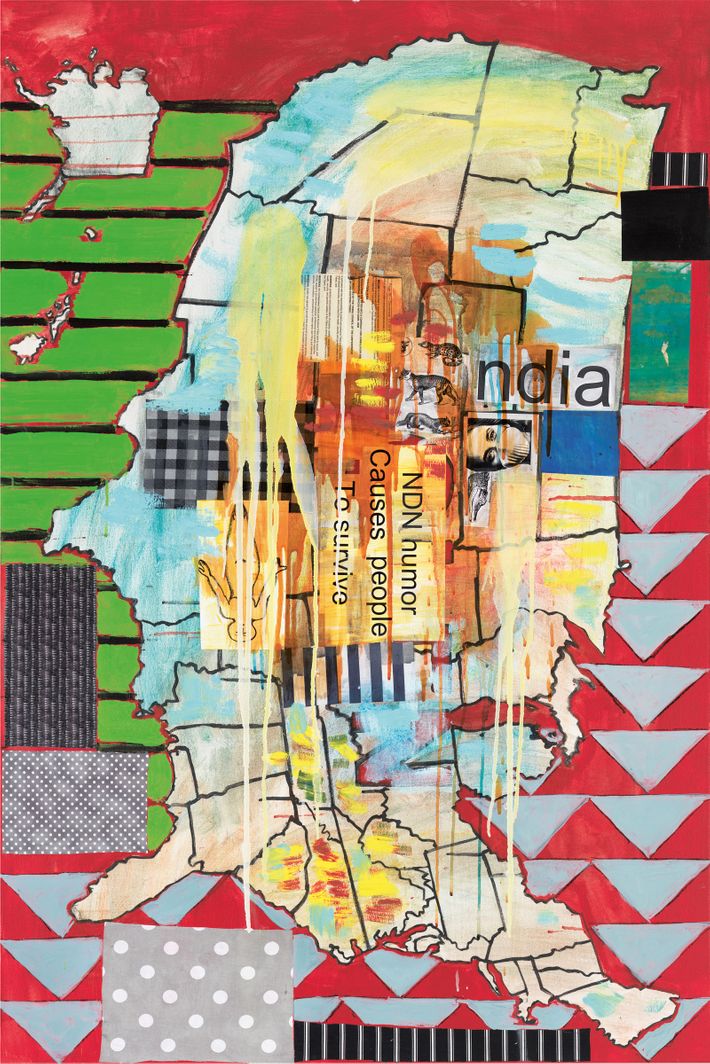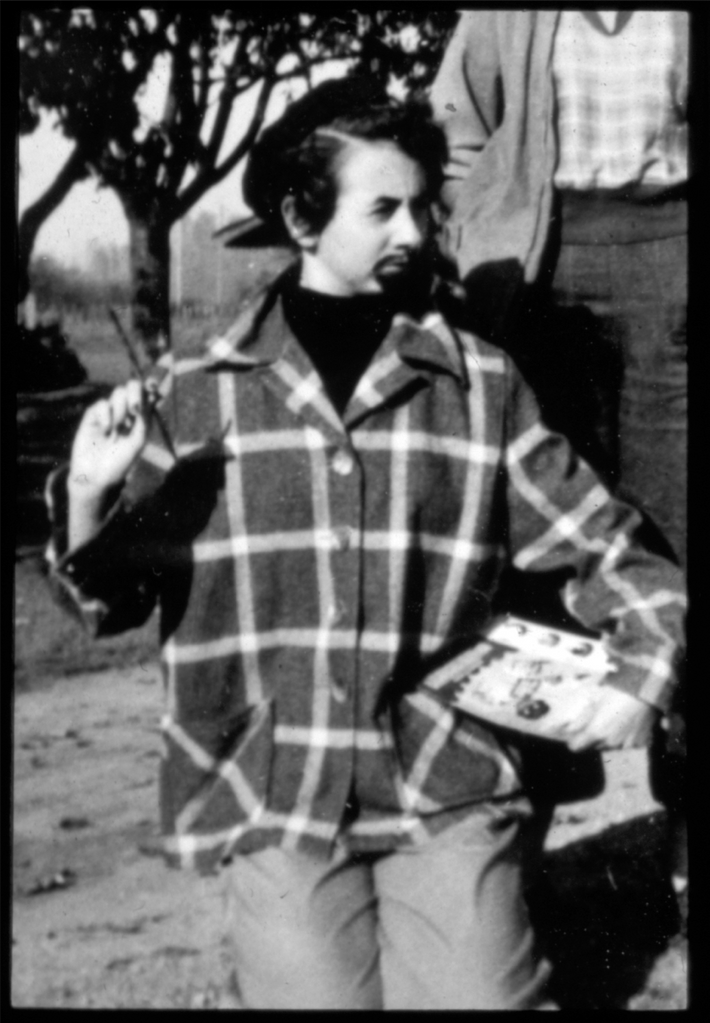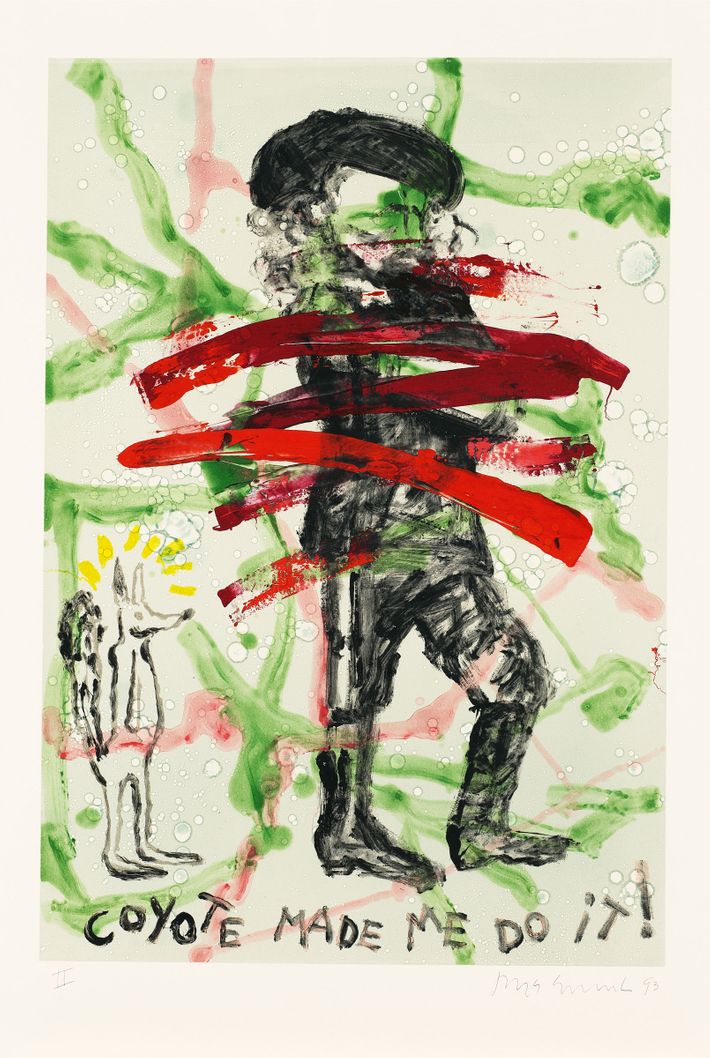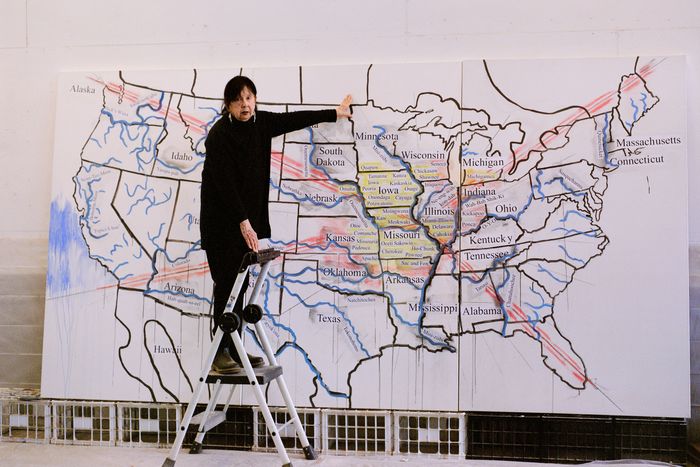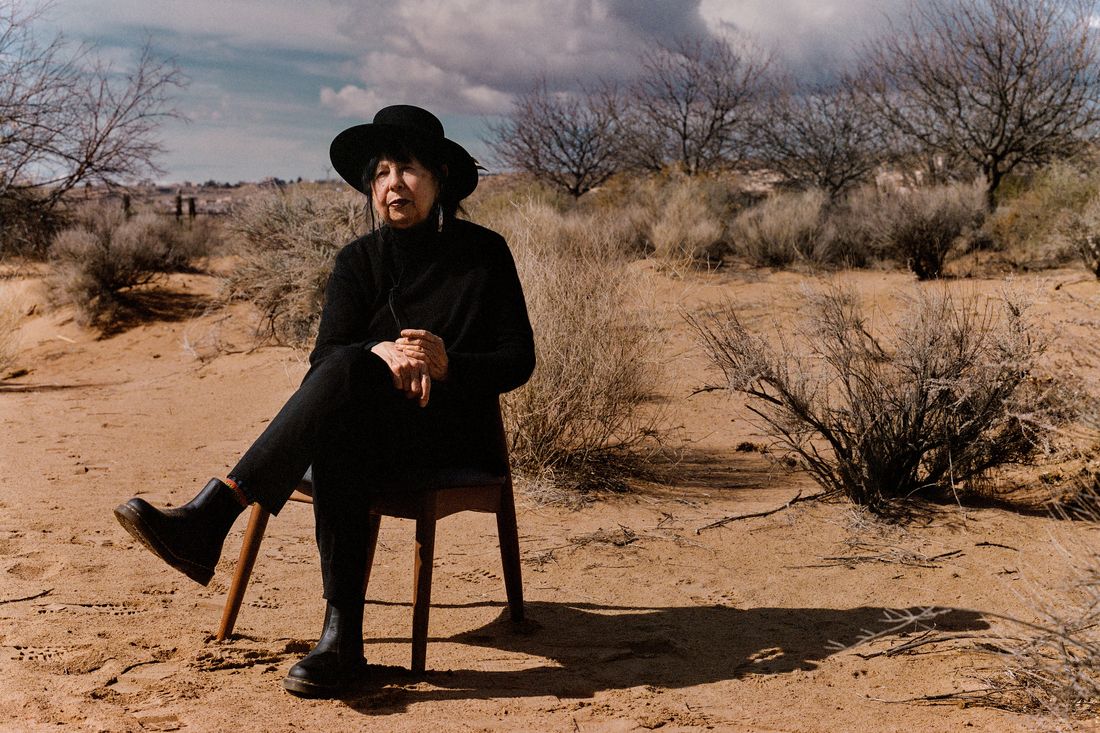
One afternoon in February, Jaune Quick-to-See Smith sat at a long table in the center of her studio in Corrales, New Mexico, surrounded by images and motifs that she returns to again and again in her artwork: sketches of George Armstrong Custer, coyote heads cast in resin, and paintings of re-imagined maps of the United States. To her left was a pile of notebooks, in which she collects words and phrases. She read from one: “Canoes. Empty Promises. Treaties.” Thumbing through another, she found a note to self: “Land acknowledgment: What’s it for?”
Just as these lines could serve as the starting point for much of her work, small talk with Smith soon grows into something bigger. She speaks deliberately and at length — about a book she’s reading, an artist she’s researching, or her disgust with Montana governor Greg Gianforte’s campaign to end federal Endangered Species Act protections for grizzly bears. “I feel like they are massacring them,” she told me. “The idea of just hunting them for trophies, to take their heads — it’s criminal to me.”
The artist, who is 83, has been deploying symbols of American empire and Native identity in her work for decades, turning oil and acrylic paint, charcoal, prints, installation, and collage into wry political commentaries on post-genocidal existence. In Indian Madonna Enthroned, from 1974, her visual grammar emerges as a kind of three-dimensional collage using materials such as dried corn, pheasant wings, and beaded hide moccasins to create a figure of a Native woman sitting on a wooden chair and clutching the book God Is Red with an American flag on her lap. Smith can work with a disarming directness that cuts through her penchant for abstract and neo-Dadaist forms: In the 1992 installation Trade (Gifts for Trading Land With White People), a selection of sports memorabilia featuring racist Indian mascots hangs over her painting of a canoe. Spam, a work on canvas from 1995, shows a painted bison atop text spelling out its title, suggesting the slow genocide of lost food traditions.
When Smith started making these kinds of pieces in the early 1970s, she said, “Nobody knew what contemporary Native art was.” Breaking into the fine-arts scene meant avoiding the more traditional Santa Fe Indian Market, an annual fair where most Native American art was sold. It also meant struggling to find the right gallerist to sell her work, which sometimes evokes Kandinsky or Rauschenberg, though in landscapes adorned with tepees, petroglyphs, and animal tracks. Other work recalls Jasper Johns. Tinged with dark humor and irony, often wrung from satirical takes on Native American imagery, it was, to the Establishment, “bastardized art,” she said, “and they didn’t see it as true or authentic.”
Smith had no road map for the kind of career she wanted. So she charted her own course. Her work has helped to prove that modernism and indigeneity can coexist across a range of mediums and materials, including the hybrid of collage and abstract painting that has become a signature style. In the ’70s, she formed an art collective called the Grey Canyon Group alongside contemporaries such as Emmi Whitehorse and Conrad House; together, they would organize what Smith said was most likely the first U.S. traveling exhibition of living Native artists. Recently, her efforts have culminated in an impressive string of unprecedented honors: Three years ago, her 1992 painting Target became the first by a Native American artist to join the permanent collection of the National Gallery of Art. This year, she’ll become the first artist to curate an exhibition there, highlighting works by roughly 50 living Native American artists. But before that, she will become the first Native American artist to have a career retrospective organized by the Whitney Museum of American Art: Her show “Memory Map” opens there on April 19. It will sprawl across two floors of the museum and include work made over the past five decades.
During Smith’s early trips to New York, she told me, “I’d be there looking out at the buildings and the neon lights and everything, and I would think, Nobody in New York knows that we’re alive. They don’t know there’s any Indians here. The American government doesn’t know we’re here. The art community has no idea.” In the decades since, Smith has learned to accept her role as an ambassador of sorts — even if she was shocked to learn that her painting could still be a first for the National Gallery.
“I am not one. I am one among many,” she said. “My community comes with me. This is how it’s always been since time immemorial. This is how we’ve survived.”
It was the physical experience of art that moved her: the sensation of dragging a stick across the dirt, at age 3, to create circles, lines, and figures representing a smaller, kinder world than the one she knew growing up in poverty. The shapes young Jaune created — animals, trees, mountains — were also a form of written language she could share with her father, an illiterate horse trader from the last generation of Salish people to grow up speaking their mother tongue; when he was sent to boarding school in the early 20th century, he was beaten for speaking it.
Jaune was born on the Flathead Indian Reservation in Montana. Her father gave her pictures of animals he’d drawn on scraps of paper, which she would carry in her pocket for weeks at a time. She brought them to school, where she studied alongside Japanese American children who had spent their earliest years in internment camps; to the fields where she worked year-round cutting rhubarb and picking seasonal fruits like strawberries and raspberries; and into the trees she climbed in search of a sturdy branch where she could hide and read books.
When I first spoke to Smith a couple of years ago, she summed up her childhood by saying she could see what was in store for her when reading the novels of John Steinbeck. Beyond her “dystopian” childhood, she imagined ending up like the Indians who came to trade horses with her father, “lost and grasping.” She felt hopeless. Then she realized that art could be more than a momentary escape. When she was 13, she watched the 1952 John Huston film Moulin Rouge, a fictionalized account of the life of Henri de Toulouse-Lautrec that gave her a different kind of hardship to dwell on: the struggles of an artist. She recognized his determination.
In high school, a counselor told her “Indians don’t go to college,” so instead of studying art or literature, she was forced to take vocational courses. The experience “was almost like getting punched in the stomach.” It didn’t stop her from pursuing art as a career. At age 16, she used money she made as a waitress and farmhand to study art through a popular correspondence course she saw advertised on the cover of a matchbook. After earning an associate art degree at a college in Washington State, she had children, then spent over a decade supporting her family as a waitress, janitor, and cannery worker. She sold her first work: a pastel piece that she remembers went for about $45. When she was able to earn a bachelor’s degree in 1976, it was in art education — the result, she told me, of a sexist system that deemed women more capable of teaching art than practicing it.
While in grad school at the University of New Mexico, she met the artists with whom she would form the Grey Canyon Group: Whitehorse, House, Larry Emerson, and Paul Willeto. She chose her gallery, Clarke-Benton in Santa Fe, in part because it represented several New York artists. At the time, this seemed about as close as a Native American could get to the cloistered Manhattan art world.
That changed for her in November 1979. That month, Smith began having shows in New York: One was on West 57th Street, around the corner from the Plaza, where her new gallerist, Jill Kornblee, gave Smith her first solo show. Later that same week, the landmark traveling show with the Grey Canyon Group opened at the American Indian Community House, a nonprofit gathering space for Indigenous New Yorkers. Smith’s friend G. Peter Jemison had set up the gallery there, and she visited every time she was in town. “I remember that we filled nail holes in the wall with toothpaste if we didn’t have the money for stucco or wood,” Smith told me. “And they were always having to move it because the rent would go up.”
At her home studio in Corrales, we were surrounded by the evidence of decades of work. A finished painting hung by the door: Shock and Awe, from 2011, which takes aim at the more recent misadventures of American empire in Iraq, depicting a mother and child in a blitzkrieg. Canvases were stacked against every wall, including a dozen or so works in progress from her series of reimagined maps of the U.S. She said that each of these is an explicit commentary on the land as a contested space; the map introduces American schoolchildren to their country in terms of its conquest by Europeans from east to west. “We see the map as a political tool,” Smith said. “It’s not an empty form to me. It’s not an icon of this incredible country.”
She reorients the map by turning it sideways and plasters it with newspaper clippings or images. In State Names Map I (2000), paint drips and oozes down the canvas to obscure what were once clearly delineated borders; Smith intended to leave only the names of states and territories derived from Indigenous sources visible, while those with European roots seem to be absent. In Tribal Map (2000), text is used to mark Indigenous communities, many of which have been moved from their homelands. Memory Map (2000), from which her Whitney retrospective draws its name, uses paintings of Indigenous petroglyphs that might be found in each area and brings to mind the stick figures she drew in the dirt as a little girl.
“I want everybody who walks in the gallery to say, ‘I don’t think I’ve ever seen a map shown that way,’” she said.
The maps’ message feels less like a public-service announcement than a scab she can’t help but pick at. Another wound she keeps returning to is the image of Custer, whose profile I saw peeking out from an otherwise blank canvas at the far end of the studio. He is a unifying motif for Native Americans: When I was growing up in Southeast Alaska, far from the plains where the U.S. Army officer waged war on nations including the Lakota Sioux and the Cheyenne in the late 19th century, I knew what he stood for long before I learned what the military had done to my own Tlingit ancestors. Among the Custer prints on display at the Whitney retrospective is one that plays on this infamy: In Coyote Made Me Do It! II (1993), Custer poses defiantly with his back to the trickster of Native American lore.
We drove to a much larger studio in a former furniture warehouse where Smith has been working on a series of canoes. “Jaune found this place,” said her son Neal Ambrose-Smith, who is also an artist. “Everything that we’re doing is in Corrales. We have our own little village that we’re able to make art in.” When we arrived, the first thing Smith did was introduce me to the team helping her prepare these mixed-media pieces alongside Ambrose-Smith: Matthew Eaton, Kelly Frye, and David Beams. She insisted that they each be credited as collaborators, which I found striking — in most cases, assistants and fabricators aren’t acknowledged at all.
“These people are all artists, too, and it’s important that their work is recognized,” Smith said.
She walked from one end of the warehouse to the other, showing me how, using reclaimed timber that they processed themselves, the team had crafted eight canoes — or, at least, the frameworks of canoes — made from long, thin strips of wood bound together with sinew and left uncovered. Most were suspended from the high ceiling, but one sat on the floor where it overflowed with sculptures of pills cast in plaster and a resin mixture, each a bit bigger than a human fist and modeled after an actual drug — OxyContin, Percocet. The canoe was made from Osage-orange wood, which Smith said had been used by Natives in Oklahoma for making bows, arrows, and cradleboards. Other canoes would be made from different woods and filled with different poisons.
“I’m using trade canoes to give back stuff that’s not good for us,” Smith said.
The legacy of Custer’s war on American Indians seemed to stare back at me from the canoe. Later, when I received the catalogue for “Memory Map,” its foreword reminded me of the intellectual legacy of relegating Native people to reservations and boarding schools: Before addressing Smith’s art or personhood, the catalogue acknowledges, briefly, that the Whitney’s “commitment to Indigenous art has been de minimis.” What “Memory Map” represents is not atonement for that sin but an embrace of sanity. Smith is one of America’s greatest living artists, and failing to acknowledge that would be madness.
At the core of her work, beyond the humor and irony and what her current gallerist Garth Greenan calls a “dense concatenation of art-historical references,” are the words she scribbles in a notebook: “Canoes. Empty Promises. Treaties.” Every piece has an earnest beginning. “It starts with a message,” Smith told me. “It starts with something true.”


